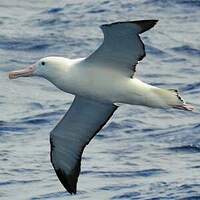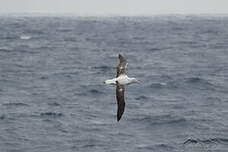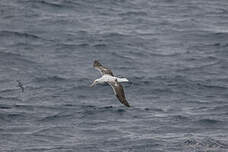Southern Royal Albatross
Diomedea epomophora - Albatros royal
Identification
This species is also known as the Southern Royal Albatross which is the largest seabird with a wingspan regularly reaching 3.5m. There are only small differences between adults and immatures. The upper body, from the head to the tip of the tail-feathers, is white; the upper wings are darker on immatures and lighter on adults, where only the primaries are truly dark, the coverts being mostly whitish and marked with darker. At all ages, the bottom is entirely white, except for the tip of the primaries. This species is distinguished from the Northern Royal Albatross (D. sanfordi) by its bigger size and lighter upper body; and from the adult Wandering Albatross (D. exulans) by the presence of a dark line between both mandibles. The plumage of the Wandering Albatross is often much darker, especially on immatures, however the difference is not always easy to make, especially with some large specimens.
Subspecific information monotypic species
Foreign names
- Albatros royal,
- Albatros real meridional,
- albatroz-real-meridional,
- Königsalbatros,
- királyalbatrosz,
- Zuidelijke Koningsalbatros,
- Albatros reale del sud,
- sydlig kungsalbatross,
- Kongealbatross,
- albatros kráľovský,
- albatros královský,
- Kongealbatros,
- kuningasalbatrossi,
- Koningmalmok (Witvlerkkoningalbatros),
- albatros reial meridional,
- Brimtrosi,
- albatros królewski,
- kraljevi albatros,
- Королевский альбатрос,
- ミナミシロアホウドリ,
- 皇信天翁,
- sydlig kungsalbatross,
- 南方皇家信天翁,
Behaviour character trait
Flight
Dietfeeding habits
Reproduction nesting
Sexual maturity isn't reached until 9 to 11 years. Due to the length of incubation (almost two and a half months) and the raising of the chick in the nest (eight months) the female of the Southern Royal Albatross only lays her single egg once every two years. The incubator stays for two to three weeks in the nest before being relieved.
Geographic range
This species of Southern Royal Albatross is endemic to New Zealand (subantarctic islands of Campbell, Enderby and Auckland). It can be observed throughout the year in all southern seas, with a range of 36° to 63° south (though it can reach as far south as 18° off the Chilean coastline). Birds that don't breed apparently don't come to land, and often circumnavigate the Earth. It is quite common offshore of Australia. Very rare in the more southerly waters. Easily observable in the springtime close to the eastern coasts of South Island, particularly offshore of Kaikoura.
Threats - protection
IUCN conservation status
concern
in the Wild
threatened
evaluated
The Southern Royal Albatross population between nesting pairs is estimated to be between 8,000 and 9,000 couples (99% on Campbell Islands), though the number of immature wandering the high seas is unknown. Before 1930, the introduction of mammals such as pigs, cats, cows and rabbits on the islands where the species reproduces caused a population decline. Since then, these mammals have been eradicated (except Auckland) and the decline has stopped. Other dangers have appeared such as the development of thick vegetation (most likely due to climate change), which prevents more and more couples from settling and the intensification of fishing with long lines as well as trawling.
Sources of information
- IOC World Bird List (v15.1), Gill, F and D Donsker (Eds). 2025-12-07.
- Albatrosses, Petrels and Shearwaters of the World, Onley Derek et Scofield Paul
- Field Guide to New Zealand Seabirds, Parkinson Brian
- Seabirds, an identification guide, Harrison Peter
- The hand guide to the birds of New Zealand, Robertson Hugh et Heather Barrie
- Vol. 1 - Handbook of the Birds of the World, Josep del Hoyo-Andrew Elliot-Jordi Sargatal
- Avibase, Lepage Denis
- BirdLife International, BirdLife International
Other sources of interest
 Specification sheet created on
29/07/2023 by Georges Olioso
Specification sheet created on
29/07/2023 by Georges OliosoTranslation by AI Oiseaux.net
© 1996-2025 Oiseaux.net
- Accipitriformes
- Aegotheliformes
- Anseriformes
- Apodiformes
- Apterygiformes
- Bucerotiformes
- Caprimulgiformes
- Cariamiformes
- Casuariiformes
- Charadriiformes
- Ciconiiformes
- Coliiformes
- Columbiformes
- Coraciiformes
- Cuculiformes
- Eurypygiformes
- Falconiformes
- Galliformes
- Gaviiformes
- Gruiformes
- Leptosomiformes
- Mesitornithiformes
- Musophagiformes
- Nyctibiiformes
- Opisthocomiformes
- Otidiformes
- Passeriformes
- Pelecaniformes
- Phaethontiformes
- Phoenicopteriformes
- Piciformes
- Podargiformes
- Podicipediformes
- Procellariiformes
- Psittaciformes
- Pterocliformes
- Rheiformes
- Sphenisciformes
- Steatornithiformes
- Strigiformes
- Struthioniformes
- Suliformes
- Tinamiformes
- Trogoniformes



























